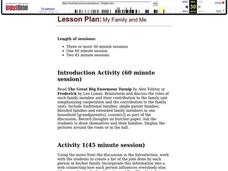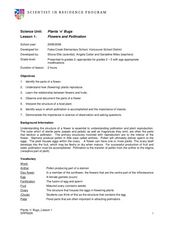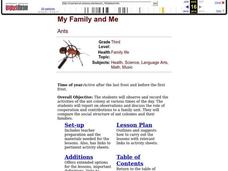Curated OER
What Bees Eat
Young scholars study plant and animal interdependence by studying bees and pollination. In this interdependence lesson, students discuss flower parts and dissect it to show its reproductive parts. Young scholars then use tissue and pipe...
Curated OER
Songs And Stories About Bees
Pupils study bees. In this nature lesson, students practice a busy bee song, read poems about bees, and discuss the concept of beekeeping.
Curated OER
My Family and Me
Students discuss the family unit and compare it to an ant colony. In this family lesson, students draw their family and extended family and talk about their jobs and family roles. They compare this to an ant colony and observe the work...
Curated OER
Major Functions
Seventh graders investigate the basic characteristics and needs of living things. They identify the major parts of plants and animals by making lists. Students focus upon one living thing and speculate how if one part is changed how it...
Curated OER
Flowers and Pollination
Young scholars explore the environment by researching plant reproduction. In this pollination instructional activity, students define botany related vocabulary terms such as disc flower, petal and fertilization. Young scholars dissect a...
Curated OER
Forest Ecology
Students examine the different plants and animals in British Columbia. In this forest ecology instructional activity students explore how ecosystems work, classify animals and investigate food webs and chains.
Curated OER
My Family and Me
Third graders observe and record the activities of the ant colony at various times of the day. They report on observations and discuss the role of cooperation and contributions to a family unit. They compare the social structure of ants.
Curated OER
Anthropods and Echinoderms
Students examine the attributes of crickets. In this arthropods lesson, students observe crickets and sketch and label their parts. Students respond to questions regarding their observations.
Curated OER
Change Through Time
In this evolution instructional activity, students will complete a table by writing in the era and biological event based on 4 different time periods of Earth's history. Students will answer 8 fill in the blank questions based on the...
Curated OER
Reptiles and Birds
In this reptile and bird worksheet, students will read a paragraph about reptile characteristics and then answer 2 short answer questions. Then students will read a paragraph about bird characteristics and complete 2 short answer questions.
Curated OER
The Earliest Primates
For this early primate worksheet, students will read information about the fossil evidence of the earliest primates. Students will complete 3 short answer questions based on their reading.
Curated OER
Arthropods
For this arthropods worksheet, students will review the 4 characteristics of arthropods and then use a lobster diagram to complete 2 short answer and 1 true or false question.
Curated OER
Nutrition and Energy Flow
In this energy flow worksheet, students will complete 10 short answer questions based on a food web diagram. Then students will review different cycles in nature including the water cycle, carbon cycle, and energy cycle. This worksheet...
Curated OER
Classifying Life
In this classifying life instructional activity, students review the 5 kingdoms of organisms by completing 10 matching and 7 fill in the blank questions.
Curated OER
Diversity of Mammals
In this mammals learning exercise, students compare and contrast the three types of mammals: placental, marsupial, and monotreme. This learning exercise has 4 short answer, 12 matching, and 8 fill in the blank questions.
Curated OER
Chemistry and the Food System
In this chemistry worksheet, students review how chemistry has helped grow and preserve different foods. This worksheet has 11 fill in the blank, 3 multiple choice, and 6 short answer questions.
Curated OER
What is a Flower?
In this flower worksheet, students use a diagram showing the different parts of a flower to complete 1 matching and 2 short answer questions.
Curated OER
What is an Animal?
In this animal worksheet, students review various characteristics that are associated with animals including body plan and skeletal structure. This worksheet has 11 fill in the blank questions.
Curated OER
Gravity
For this gravity worksheet, students complete a crossword puzzle by determining the correct terms associated with the 12 statements about erosion and landslides.
Curated OER
Forest Ecosystem Field Trip
Students investigate the environment by participating in a class field trip. In this botany lesson, students attend a field trip through their local park or forest while listening to a nature guide. Students practice using their 5 senses...
Curated OER
Decomposers- Nurse Logs
Pupils investigate temperate forest ecosystems. In this environmental lesson, students discover different forms of decomposition and its effect on the environment.
Curated OER
Venus Flytrap
Students study the Venus Flytrap including its habitat and how it eats. In this ecology lesson students complete several experiments using a Venus Flytrap to see how it reacts to various conditions.
Curated OER
Arthropod Coloring Worksheet
In this biology worksheet, learners color and label the different parts of arthropods. They complete 63 short answer and fill in the blank questions on arthropods.
Curated OER
The Listening Walk
Students play instruments that reflect sounds in the story: hoots, toots, creaking, shrieks, clacking, crunching, whooshing, etc. They make vocal sounds from the story: whispered, sniffled, sigh, giggled, croaked, laughed. The...
Other popular searches
- K 2 Life Science Insects
- Science Insects
- Parts of Insects Science
- Life Science Insects
- Science Spiders vs Insects
- Esl Lessons Science Insects
- Esl Science Insects

























